Importance of Strategic HRM: McDonald's Case Study Analysis
VerifiedAdded on 2023/01/12
|7
|2447
|42
Report
AI Summary
This report provides a detailed analysis of McDonald's strategic human resource management (HRM) practices. It examines the company's approach to various HRM functions, including recruitment and selection, training and development, employee motivation, performance management, and employee relations. The report highlights the importance of training programs in enhancing employee skills and productivity, as well as the role of effective performance management systems. It also explores how McDonald's fosters employee engagement through strategies such as flexible work environments, employee participation in decision-making, and compensation and rewards programs. The case study emphasizes the impact of strategic HRM on operational efficiency, financial performance, and overall organizational success. The report also discusses how employee relations and organizational culture contribute to employee engagement and the importance of balancing work-life for employees. Ultimately, the report underscores the significance of a progressive HRM policy in driving employee engagement, productivity, and organizational effectiveness.
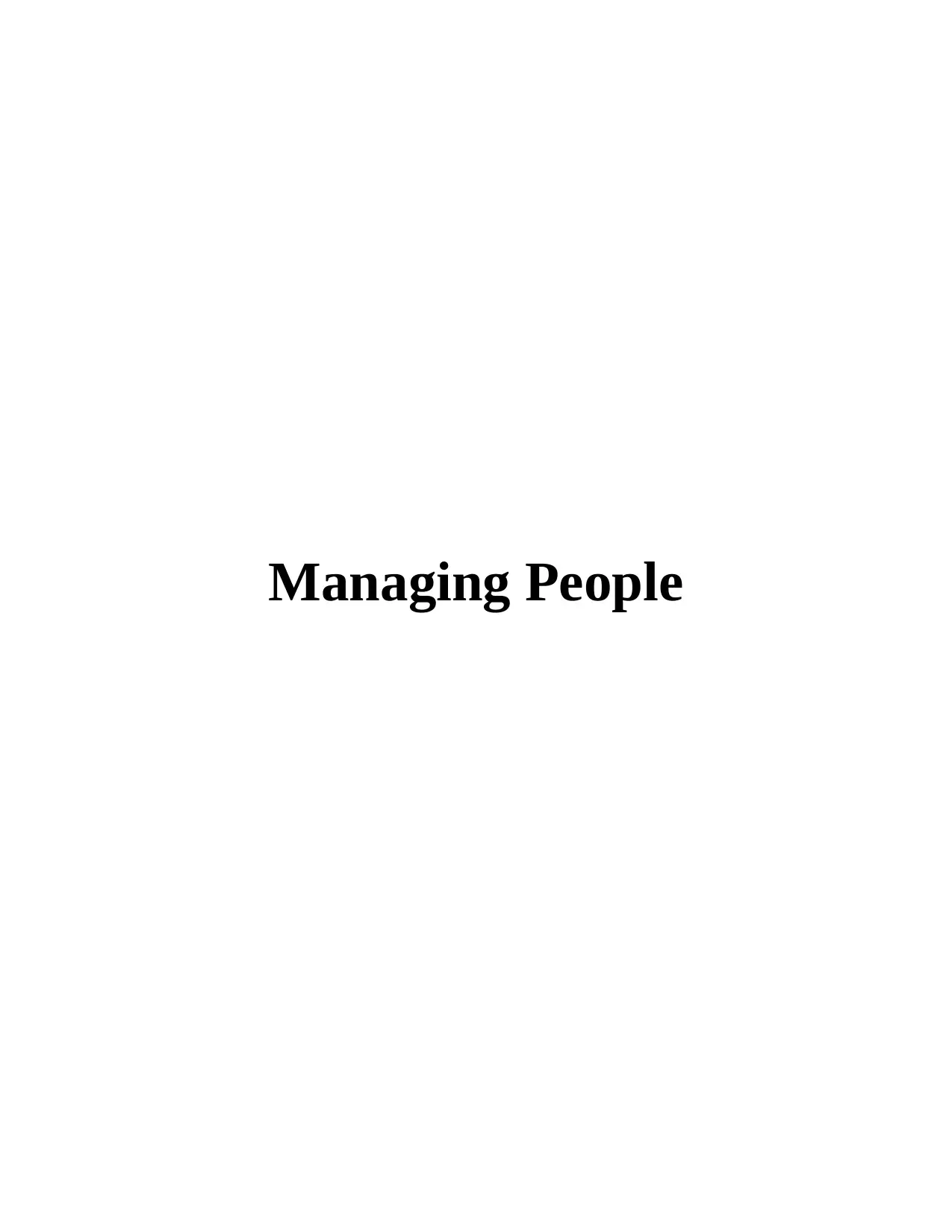
Managing People
Paraphrase This Document
Need a fresh take? Get an instant paraphrase of this document with our AI Paraphraser
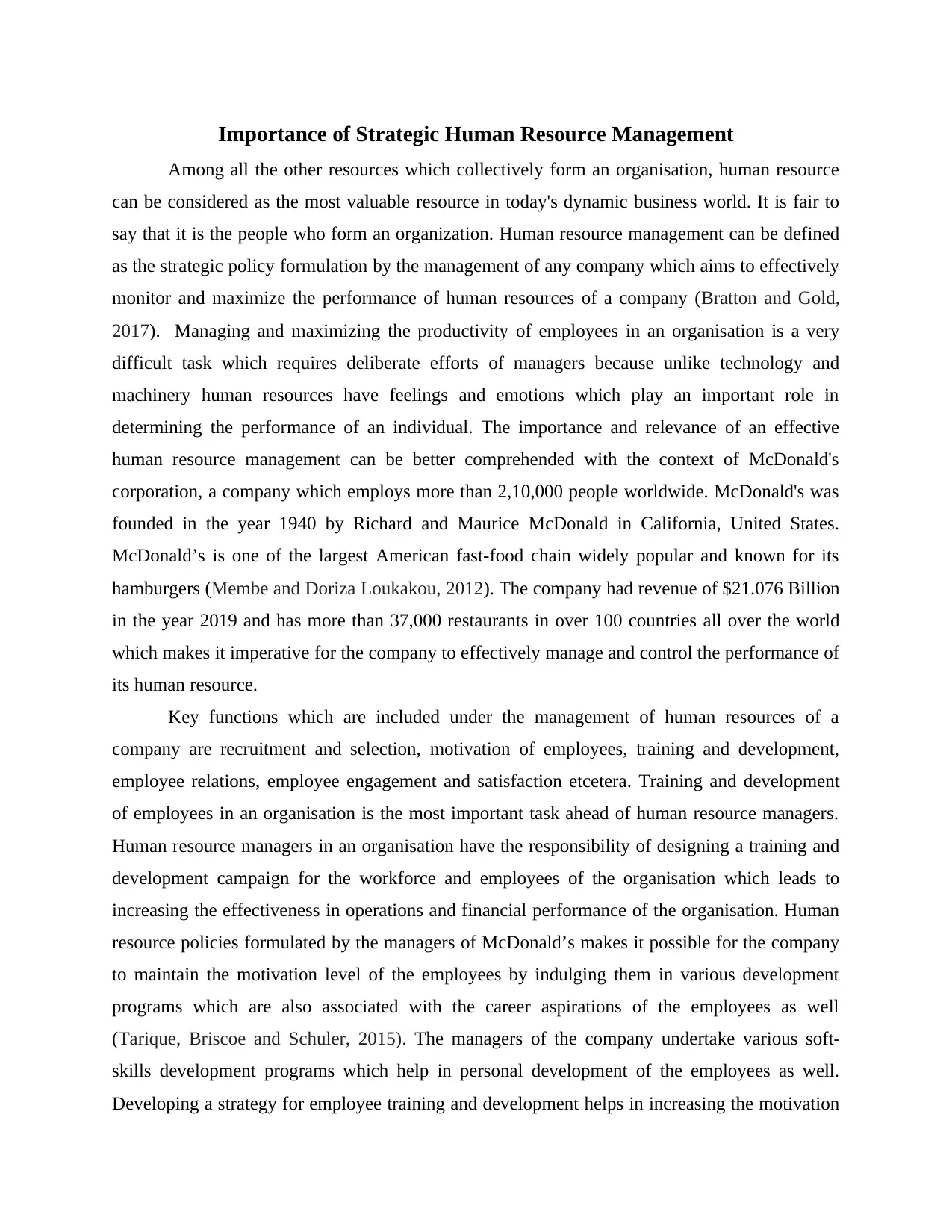
Importance of Strategic Human Resource Management
Among all the other resources which collectively form an organisation, human resource
can be considered as the most valuable resource in today's dynamic business world. It is fair to
say that it is the people who form an organization. Human resource management can be defined
as the strategic policy formulation by the management of any company which aims to effectively
monitor and maximize the performance of human resources of a company (Bratton and Gold,
2017). Managing and maximizing the productivity of employees in an organisation is a very
difficult task which requires deliberate efforts of managers because unlike technology and
machinery human resources have feelings and emotions which play an important role in
determining the performance of an individual. The importance and relevance of an effective
human resource management can be better comprehended with the context of McDonald's
corporation, a company which employs more than 2,10,000 people worldwide. McDonald's was
founded in the year 1940 by Richard and Maurice McDonald in California, United States.
McDonald’s is one of the largest American fast-food chain widely popular and known for its
hamburgers (Membe and Doriza Loukakou, 2012). The company had revenue of $21.076 Billion
in the year 2019 and has more than 37,000 restaurants in over 100 countries all over the world
which makes it imperative for the company to effectively manage and control the performance of
its human resource.
Key functions which are included under the management of human resources of a
company are recruitment and selection, motivation of employees, training and development,
employee relations, employee engagement and satisfaction etcetera. Training and development
of employees in an organisation is the most important task ahead of human resource managers.
Human resource managers in an organisation have the responsibility of designing a training and
development campaign for the workforce and employees of the organisation which leads to
increasing the effectiveness in operations and financial performance of the organisation. Human
resource policies formulated by the managers of McDonald’s makes it possible for the company
to maintain the motivation level of the employees by indulging them in various development
programs which are also associated with the career aspirations of the employees as well
(Tarique, Briscoe and Schuler, 2015). The managers of the company undertake various soft-
skills development programs which help in personal development of the employees as well.
Developing a strategy for employee training and development helps in increasing the motivation
Among all the other resources which collectively form an organisation, human resource
can be considered as the most valuable resource in today's dynamic business world. It is fair to
say that it is the people who form an organization. Human resource management can be defined
as the strategic policy formulation by the management of any company which aims to effectively
monitor and maximize the performance of human resources of a company (Bratton and Gold,
2017). Managing and maximizing the productivity of employees in an organisation is a very
difficult task which requires deliberate efforts of managers because unlike technology and
machinery human resources have feelings and emotions which play an important role in
determining the performance of an individual. The importance and relevance of an effective
human resource management can be better comprehended with the context of McDonald's
corporation, a company which employs more than 2,10,000 people worldwide. McDonald's was
founded in the year 1940 by Richard and Maurice McDonald in California, United States.
McDonald’s is one of the largest American fast-food chain widely popular and known for its
hamburgers (Membe and Doriza Loukakou, 2012). The company had revenue of $21.076 Billion
in the year 2019 and has more than 37,000 restaurants in over 100 countries all over the world
which makes it imperative for the company to effectively manage and control the performance of
its human resource.
Key functions which are included under the management of human resources of a
company are recruitment and selection, motivation of employees, training and development,
employee relations, employee engagement and satisfaction etcetera. Training and development
of employees in an organisation is the most important task ahead of human resource managers.
Human resource managers in an organisation have the responsibility of designing a training and
development campaign for the workforce and employees of the organisation which leads to
increasing the effectiveness in operations and financial performance of the organisation. Human
resource policies formulated by the managers of McDonald’s makes it possible for the company
to maintain the motivation level of the employees by indulging them in various development
programs which are also associated with the career aspirations of the employees as well
(Tarique, Briscoe and Schuler, 2015). The managers of the company undertake various soft-
skills development programs which help in personal development of the employees as well.
Developing a strategy for employee training and development helps in increasing the motivation
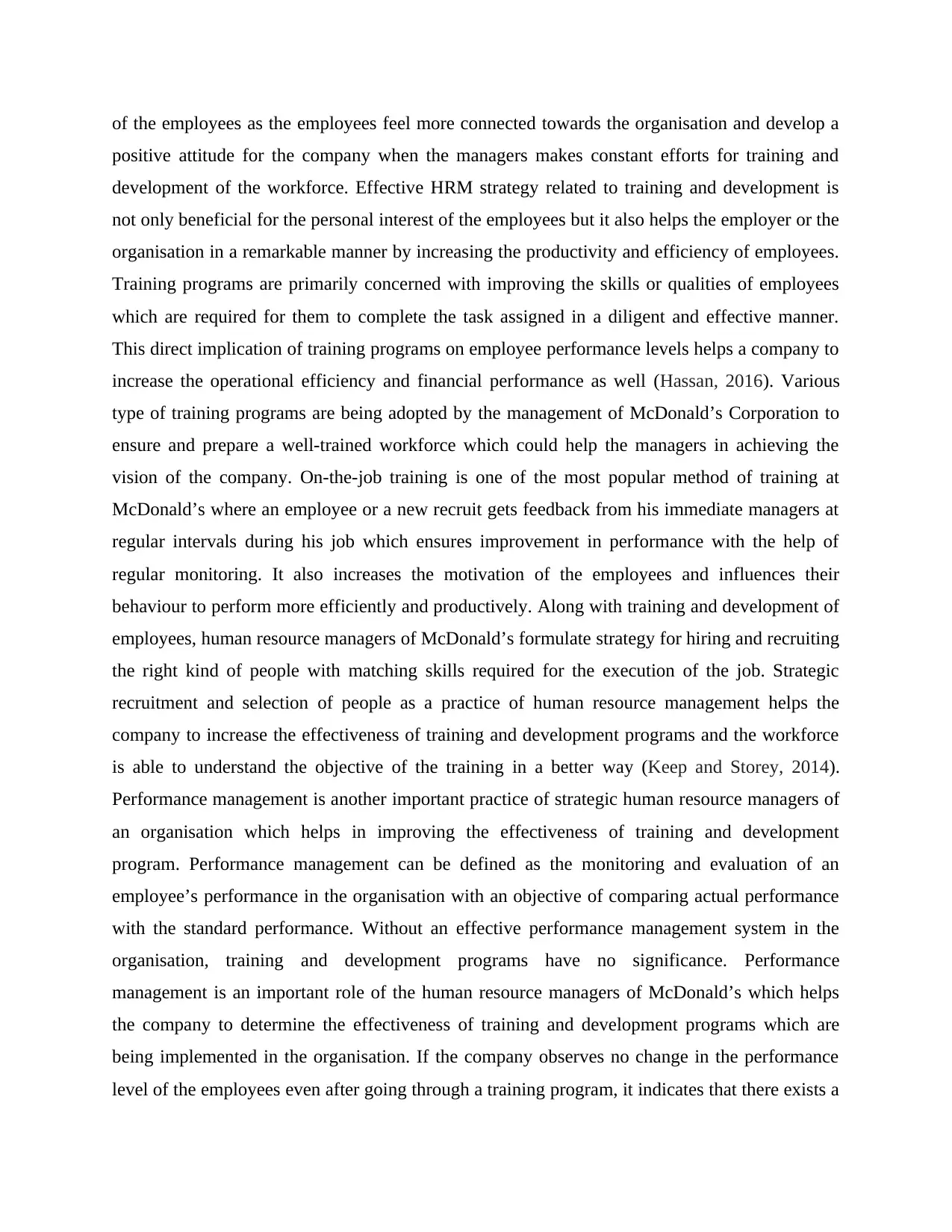
of the employees as the employees feel more connected towards the organisation and develop a
positive attitude for the company when the managers makes constant efforts for training and
development of the workforce. Effective HRM strategy related to training and development is
not only beneficial for the personal interest of the employees but it also helps the employer or the
organisation in a remarkable manner by increasing the productivity and efficiency of employees.
Training programs are primarily concerned with improving the skills or qualities of employees
which are required for them to complete the task assigned in a diligent and effective manner.
This direct implication of training programs on employee performance levels helps a company to
increase the operational efficiency and financial performance as well (Hassan, 2016). Various
type of training programs are being adopted by the management of McDonald’s Corporation to
ensure and prepare a well-trained workforce which could help the managers in achieving the
vision of the company. On-the-job training is one of the most popular method of training at
McDonald’s where an employee or a new recruit gets feedback from his immediate managers at
regular intervals during his job which ensures improvement in performance with the help of
regular monitoring. It also increases the motivation of the employees and influences their
behaviour to perform more efficiently and productively. Along with training and development of
employees, human resource managers of McDonald’s formulate strategy for hiring and recruiting
the right kind of people with matching skills required for the execution of the job. Strategic
recruitment and selection of people as a practice of human resource management helps the
company to increase the effectiveness of training and development programs and the workforce
is able to understand the objective of the training in a better way (Keep and Storey, 2014).
Performance management is another important practice of strategic human resource managers of
an organisation which helps in improving the effectiveness of training and development
program. Performance management can be defined as the monitoring and evaluation of an
employee’s performance in the organisation with an objective of comparing actual performance
with the standard performance. Without an effective performance management system in the
organisation, training and development programs have no significance. Performance
management is an important role of the human resource managers of McDonald’s which helps
the company to determine the effectiveness of training and development programs which are
being implemented in the organisation. If the company observes no change in the performance
level of the employees even after going through a training program, it indicates that there exists a
positive attitude for the company when the managers makes constant efforts for training and
development of the workforce. Effective HRM strategy related to training and development is
not only beneficial for the personal interest of the employees but it also helps the employer or the
organisation in a remarkable manner by increasing the productivity and efficiency of employees.
Training programs are primarily concerned with improving the skills or qualities of employees
which are required for them to complete the task assigned in a diligent and effective manner.
This direct implication of training programs on employee performance levels helps a company to
increase the operational efficiency and financial performance as well (Hassan, 2016). Various
type of training programs are being adopted by the management of McDonald’s Corporation to
ensure and prepare a well-trained workforce which could help the managers in achieving the
vision of the company. On-the-job training is one of the most popular method of training at
McDonald’s where an employee or a new recruit gets feedback from his immediate managers at
regular intervals during his job which ensures improvement in performance with the help of
regular monitoring. It also increases the motivation of the employees and influences their
behaviour to perform more efficiently and productively. Along with training and development of
employees, human resource managers of McDonald’s formulate strategy for hiring and recruiting
the right kind of people with matching skills required for the execution of the job. Strategic
recruitment and selection of people as a practice of human resource management helps the
company to increase the effectiveness of training and development programs and the workforce
is able to understand the objective of the training in a better way (Keep and Storey, 2014).
Performance management is another important practice of strategic human resource managers of
an organisation which helps in improving the effectiveness of training and development
program. Performance management can be defined as the monitoring and evaluation of an
employee’s performance in the organisation with an objective of comparing actual performance
with the standard performance. Without an effective performance management system in the
organisation, training and development programs have no significance. Performance
management is an important role of the human resource managers of McDonald’s which helps
the company to determine the effectiveness of training and development programs which are
being implemented in the organisation. If the company observes no change in the performance
level of the employees even after going through a training program, it indicates that there exists a
⊘ This is a preview!⊘
Do you want full access?
Subscribe today to unlock all pages.

Trusted by 1+ million students worldwide
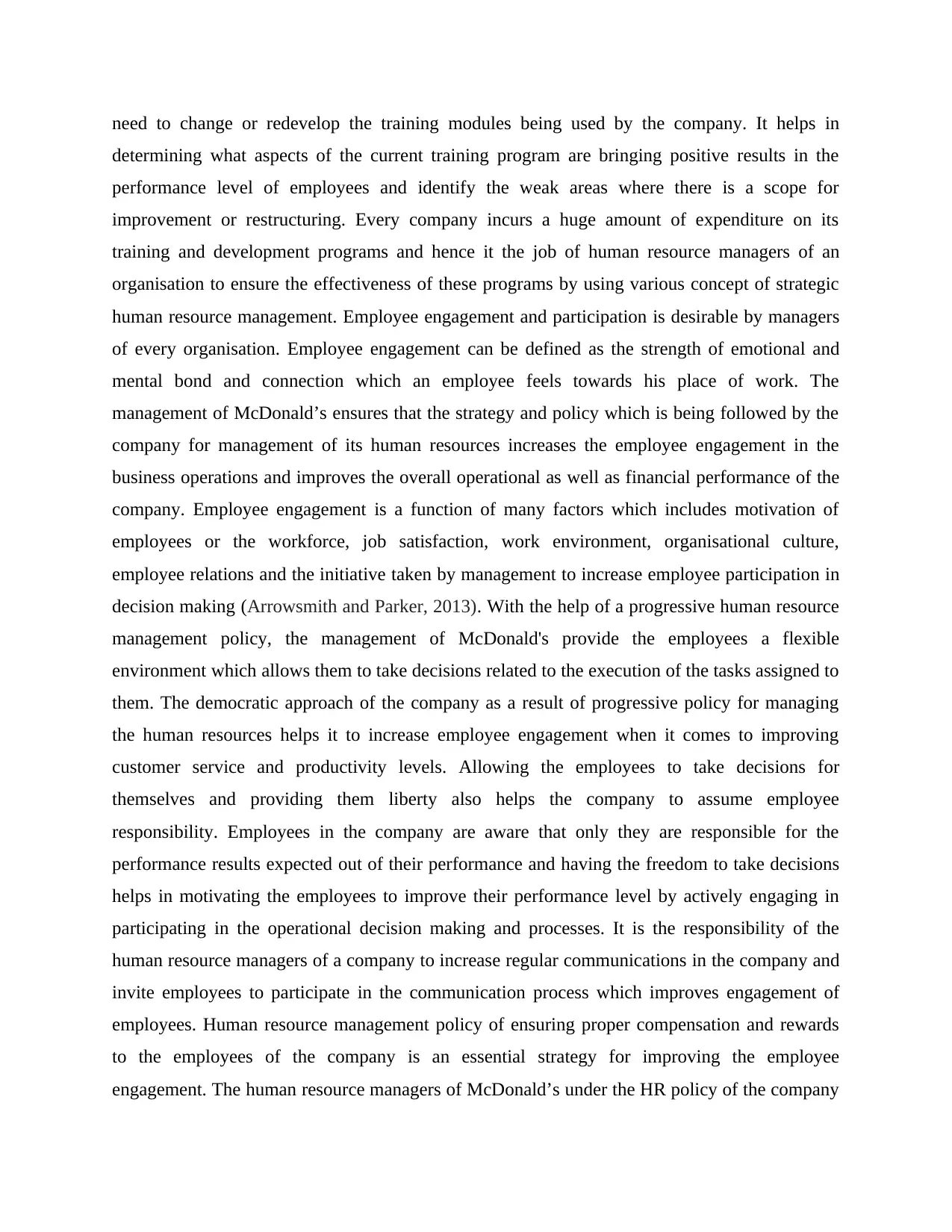
need to change or redevelop the training modules being used by the company. It helps in
determining what aspects of the current training program are bringing positive results in the
performance level of employees and identify the weak areas where there is a scope for
improvement or restructuring. Every company incurs a huge amount of expenditure on its
training and development programs and hence it the job of human resource managers of an
organisation to ensure the effectiveness of these programs by using various concept of strategic
human resource management. Employee engagement and participation is desirable by managers
of every organisation. Employee engagement can be defined as the strength of emotional and
mental bond and connection which an employee feels towards his place of work. The
management of McDonald’s ensures that the strategy and policy which is being followed by the
company for management of its human resources increases the employee engagement in the
business operations and improves the overall operational as well as financial performance of the
company. Employee engagement is a function of many factors which includes motivation of
employees or the workforce, job satisfaction, work environment, organisational culture,
employee relations and the initiative taken by management to increase employee participation in
decision making (Arrowsmith and Parker, 2013). With the help of a progressive human resource
management policy, the management of McDonald's provide the employees a flexible
environment which allows them to take decisions related to the execution of the tasks assigned to
them. The democratic approach of the company as a result of progressive policy for managing
the human resources helps it to increase employee engagement when it comes to improving
customer service and productivity levels. Allowing the employees to take decisions for
themselves and providing them liberty also helps the company to assume employee
responsibility. Employees in the company are aware that only they are responsible for the
performance results expected out of their performance and having the freedom to take decisions
helps in motivating the employees to improve their performance level by actively engaging in
participating in the operational decision making and processes. It is the responsibility of the
human resource managers of a company to increase regular communications in the company and
invite employees to participate in the communication process which improves engagement of
employees. Human resource management policy of ensuring proper compensation and rewards
to the employees of the company is an essential strategy for improving the employee
engagement. The human resource managers of McDonald’s under the HR policy of the company
determining what aspects of the current training program are bringing positive results in the
performance level of employees and identify the weak areas where there is a scope for
improvement or restructuring. Every company incurs a huge amount of expenditure on its
training and development programs and hence it the job of human resource managers of an
organisation to ensure the effectiveness of these programs by using various concept of strategic
human resource management. Employee engagement and participation is desirable by managers
of every organisation. Employee engagement can be defined as the strength of emotional and
mental bond and connection which an employee feels towards his place of work. The
management of McDonald’s ensures that the strategy and policy which is being followed by the
company for management of its human resources increases the employee engagement in the
business operations and improves the overall operational as well as financial performance of the
company. Employee engagement is a function of many factors which includes motivation of
employees or the workforce, job satisfaction, work environment, organisational culture,
employee relations and the initiative taken by management to increase employee participation in
decision making (Arrowsmith and Parker, 2013). With the help of a progressive human resource
management policy, the management of McDonald's provide the employees a flexible
environment which allows them to take decisions related to the execution of the tasks assigned to
them. The democratic approach of the company as a result of progressive policy for managing
the human resources helps it to increase employee engagement when it comes to improving
customer service and productivity levels. Allowing the employees to take decisions for
themselves and providing them liberty also helps the company to assume employee
responsibility. Employees in the company are aware that only they are responsible for the
performance results expected out of their performance and having the freedom to take decisions
helps in motivating the employees to improve their performance level by actively engaging in
participating in the operational decision making and processes. It is the responsibility of the
human resource managers of a company to increase regular communications in the company and
invite employees to participate in the communication process which improves engagement of
employees. Human resource management policy of ensuring proper compensation and rewards
to the employees of the company is an essential strategy for improving the employee
engagement. The human resource managers of McDonald’s under the HR policy of the company
Paraphrase This Document
Need a fresh take? Get an instant paraphrase of this document with our AI Paraphraser
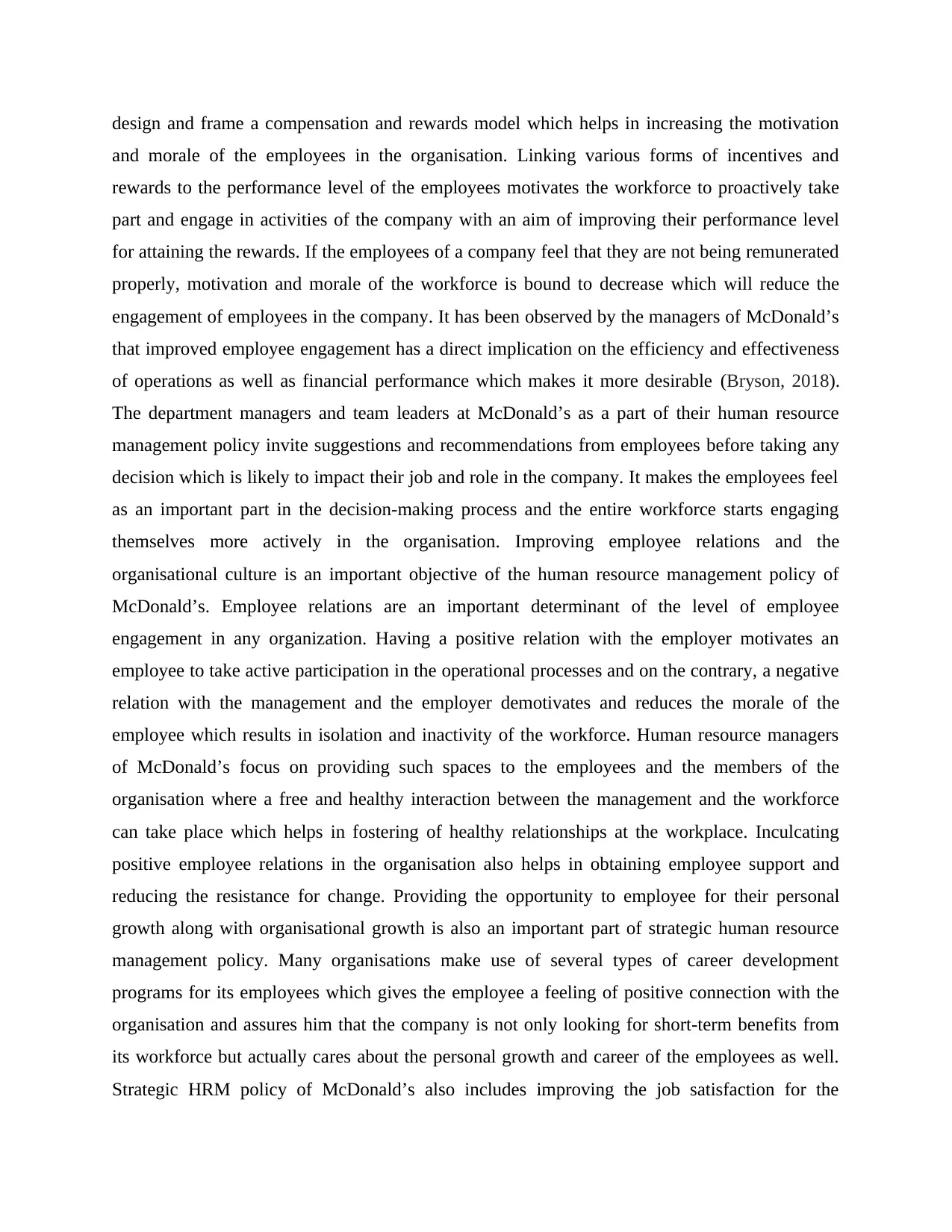
design and frame a compensation and rewards model which helps in increasing the motivation
and morale of the employees in the organisation. Linking various forms of incentives and
rewards to the performance level of the employees motivates the workforce to proactively take
part and engage in activities of the company with an aim of improving their performance level
for attaining the rewards. If the employees of a company feel that they are not being remunerated
properly, motivation and morale of the workforce is bound to decrease which will reduce the
engagement of employees in the company. It has been observed by the managers of McDonald’s
that improved employee engagement has a direct implication on the efficiency and effectiveness
of operations as well as financial performance which makes it more desirable (Bryson, 2018).
The department managers and team leaders at McDonald’s as a part of their human resource
management policy invite suggestions and recommendations from employees before taking any
decision which is likely to impact their job and role in the company. It makes the employees feel
as an important part in the decision-making process and the entire workforce starts engaging
themselves more actively in the organisation. Improving employee relations and the
organisational culture is an important objective of the human resource management policy of
McDonald’s. Employee relations are an important determinant of the level of employee
engagement in any organization. Having a positive relation with the employer motivates an
employee to take active participation in the operational processes and on the contrary, a negative
relation with the management and the employer demotivates and reduces the morale of the
employee which results in isolation and inactivity of the workforce. Human resource managers
of McDonald’s focus on providing such spaces to the employees and the members of the
organisation where a free and healthy interaction between the management and the workforce
can take place which helps in fostering of healthy relationships at the workplace. Inculcating
positive employee relations in the organisation also helps in obtaining employee support and
reducing the resistance for change. Providing the opportunity to employee for their personal
growth along with organisational growth is also an important part of strategic human resource
management policy. Many organisations make use of several types of career development
programs for its employees which gives the employee a feeling of positive connection with the
organisation and assures him that the company is not only looking for short-term benefits from
its workforce but actually cares about the personal growth and career of the employees as well.
Strategic HRM policy of McDonald’s also includes improving the job satisfaction for the
and morale of the employees in the organisation. Linking various forms of incentives and
rewards to the performance level of the employees motivates the workforce to proactively take
part and engage in activities of the company with an aim of improving their performance level
for attaining the rewards. If the employees of a company feel that they are not being remunerated
properly, motivation and morale of the workforce is bound to decrease which will reduce the
engagement of employees in the company. It has been observed by the managers of McDonald’s
that improved employee engagement has a direct implication on the efficiency and effectiveness
of operations as well as financial performance which makes it more desirable (Bryson, 2018).
The department managers and team leaders at McDonald’s as a part of their human resource
management policy invite suggestions and recommendations from employees before taking any
decision which is likely to impact their job and role in the company. It makes the employees feel
as an important part in the decision-making process and the entire workforce starts engaging
themselves more actively in the organisation. Improving employee relations and the
organisational culture is an important objective of the human resource management policy of
McDonald’s. Employee relations are an important determinant of the level of employee
engagement in any organization. Having a positive relation with the employer motivates an
employee to take active participation in the operational processes and on the contrary, a negative
relation with the management and the employer demotivates and reduces the morale of the
employee which results in isolation and inactivity of the workforce. Human resource managers
of McDonald’s focus on providing such spaces to the employees and the members of the
organisation where a free and healthy interaction between the management and the workforce
can take place which helps in fostering of healthy relationships at the workplace. Inculcating
positive employee relations in the organisation also helps in obtaining employee support and
reducing the resistance for change. Providing the opportunity to employee for their personal
growth along with organisational growth is also an important part of strategic human resource
management policy. Many organisations make use of several types of career development
programs for its employees which gives the employee a feeling of positive connection with the
organisation and assures him that the company is not only looking for short-term benefits from
its workforce but actually cares about the personal growth and career of the employees as well.
Strategic HRM policy of McDonald’s also includes improving the job satisfaction for the
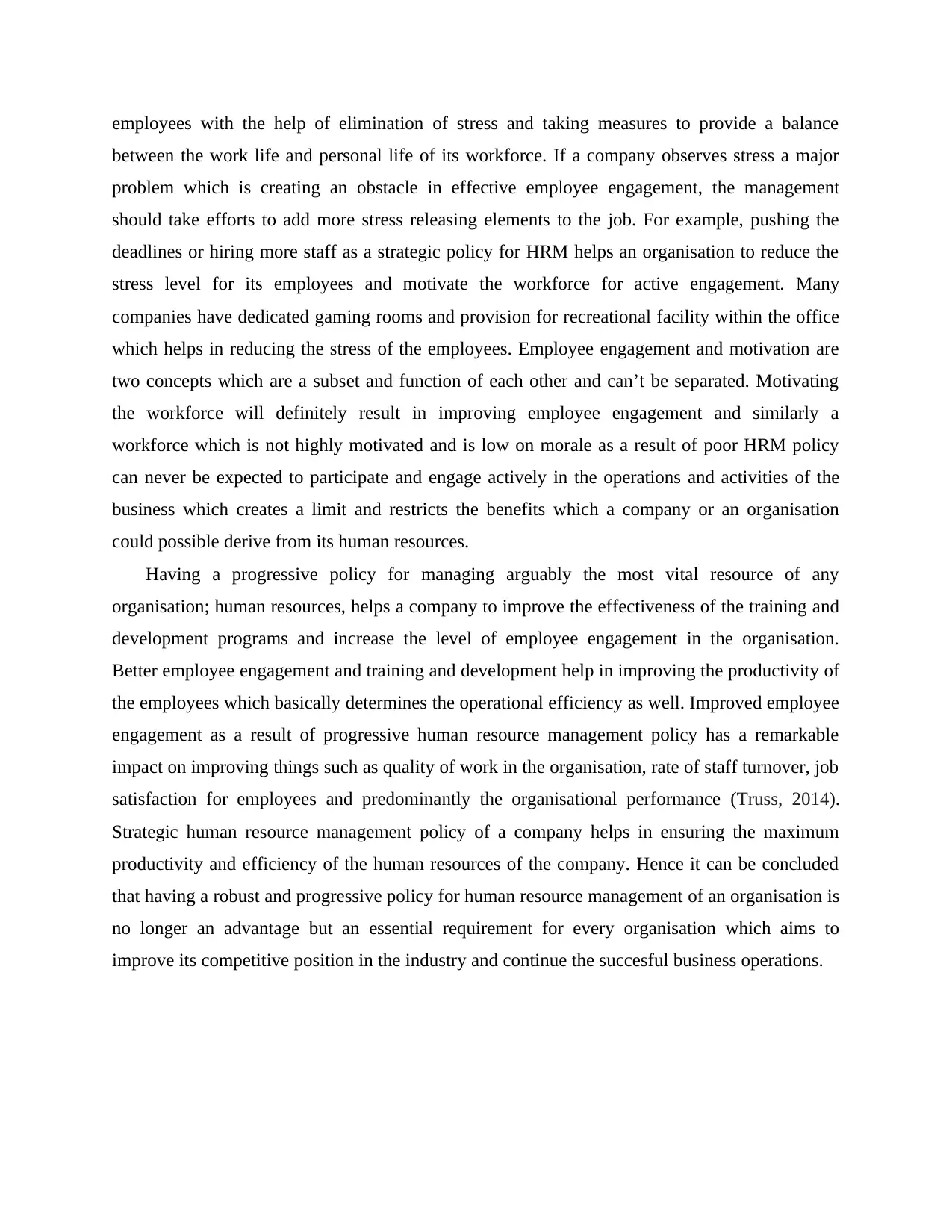
employees with the help of elimination of stress and taking measures to provide a balance
between the work life and personal life of its workforce. If a company observes stress a major
problem which is creating an obstacle in effective employee engagement, the management
should take efforts to add more stress releasing elements to the job. For example, pushing the
deadlines or hiring more staff as a strategic policy for HRM helps an organisation to reduce the
stress level for its employees and motivate the workforce for active engagement. Many
companies have dedicated gaming rooms and provision for recreational facility within the office
which helps in reducing the stress of the employees. Employee engagement and motivation are
two concepts which are a subset and function of each other and can’t be separated. Motivating
the workforce will definitely result in improving employee engagement and similarly a
workforce which is not highly motivated and is low on morale as a result of poor HRM policy
can never be expected to participate and engage actively in the operations and activities of the
business which creates a limit and restricts the benefits which a company or an organisation
could possible derive from its human resources.
Having a progressive policy for managing arguably the most vital resource of any
organisation; human resources, helps a company to improve the effectiveness of the training and
development programs and increase the level of employee engagement in the organisation.
Better employee engagement and training and development help in improving the productivity of
the employees which basically determines the operational efficiency as well. Improved employee
engagement as a result of progressive human resource management policy has a remarkable
impact on improving things such as quality of work in the organisation, rate of staff turnover, job
satisfaction for employees and predominantly the organisational performance (Truss, 2014).
Strategic human resource management policy of a company helps in ensuring the maximum
productivity and efficiency of the human resources of the company. Hence it can be concluded
that having a robust and progressive policy for human resource management of an organisation is
no longer an advantage but an essential requirement for every organisation which aims to
improve its competitive position in the industry and continue the succesful business operations.
between the work life and personal life of its workforce. If a company observes stress a major
problem which is creating an obstacle in effective employee engagement, the management
should take efforts to add more stress releasing elements to the job. For example, pushing the
deadlines or hiring more staff as a strategic policy for HRM helps an organisation to reduce the
stress level for its employees and motivate the workforce for active engagement. Many
companies have dedicated gaming rooms and provision for recreational facility within the office
which helps in reducing the stress of the employees. Employee engagement and motivation are
two concepts which are a subset and function of each other and can’t be separated. Motivating
the workforce will definitely result in improving employee engagement and similarly a
workforce which is not highly motivated and is low on morale as a result of poor HRM policy
can never be expected to participate and engage actively in the operations and activities of the
business which creates a limit and restricts the benefits which a company or an organisation
could possible derive from its human resources.
Having a progressive policy for managing arguably the most vital resource of any
organisation; human resources, helps a company to improve the effectiveness of the training and
development programs and increase the level of employee engagement in the organisation.
Better employee engagement and training and development help in improving the productivity of
the employees which basically determines the operational efficiency as well. Improved employee
engagement as a result of progressive human resource management policy has a remarkable
impact on improving things such as quality of work in the organisation, rate of staff turnover, job
satisfaction for employees and predominantly the organisational performance (Truss, 2014).
Strategic human resource management policy of a company helps in ensuring the maximum
productivity and efficiency of the human resources of the company. Hence it can be concluded
that having a robust and progressive policy for human resource management of an organisation is
no longer an advantage but an essential requirement for every organisation which aims to
improve its competitive position in the industry and continue the succesful business operations.
⊘ This is a preview!⊘
Do you want full access?
Subscribe today to unlock all pages.

Trusted by 1+ million students worldwide
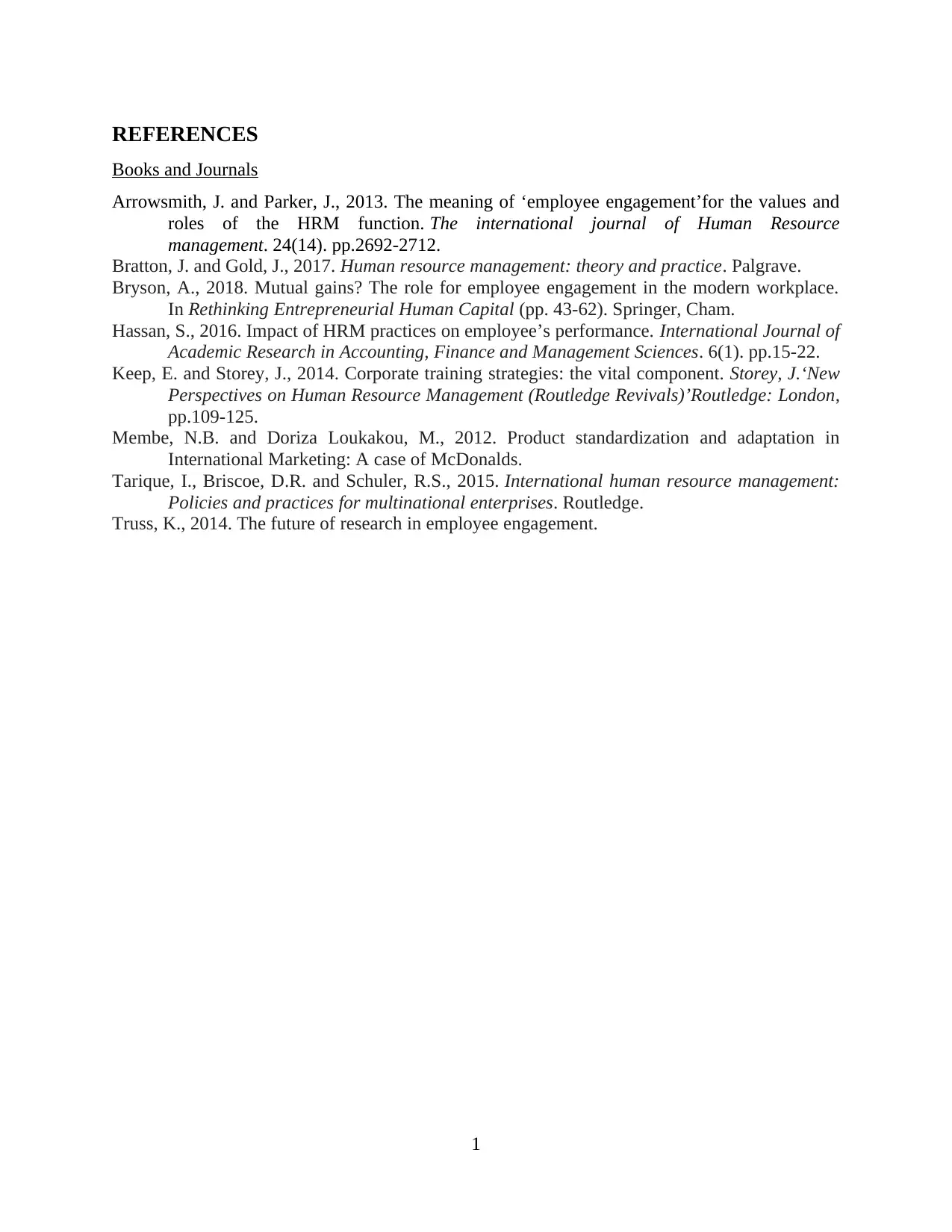
REFERENCES
Books and Journals
Arrowsmith, J. and Parker, J., 2013. The meaning of ‘employee engagement’for the values and
roles of the HRM function. The international journal of Human Resource
management. 24(14). pp.2692-2712.
Bratton, J. and Gold, J., 2017. Human resource management: theory and practice. Palgrave.
Bryson, A., 2018. Mutual gains? The role for employee engagement in the modern workplace.
In Rethinking Entrepreneurial Human Capital (pp. 43-62). Springer, Cham.
Hassan, S., 2016. Impact of HRM practices on employee’s performance. International Journal of
Academic Research in Accounting, Finance and Management Sciences. 6(1). pp.15-22.
Keep, E. and Storey, J., 2014. Corporate training strategies: the vital component. Storey, J.‘New
Perspectives on Human Resource Management (Routledge Revivals)’Routledge: London,
pp.109-125.
Membe, N.B. and Doriza Loukakou, M., 2012. Product standardization and adaptation in
International Marketing: A case of McDonalds.
Tarique, I., Briscoe, D.R. and Schuler, R.S., 2015. International human resource management:
Policies and practices for multinational enterprises. Routledge.
Truss, K., 2014. The future of research in employee engagement.
1
Books and Journals
Arrowsmith, J. and Parker, J., 2013. The meaning of ‘employee engagement’for the values and
roles of the HRM function. The international journal of Human Resource
management. 24(14). pp.2692-2712.
Bratton, J. and Gold, J., 2017. Human resource management: theory and practice. Palgrave.
Bryson, A., 2018. Mutual gains? The role for employee engagement in the modern workplace.
In Rethinking Entrepreneurial Human Capital (pp. 43-62). Springer, Cham.
Hassan, S., 2016. Impact of HRM practices on employee’s performance. International Journal of
Academic Research in Accounting, Finance and Management Sciences. 6(1). pp.15-22.
Keep, E. and Storey, J., 2014. Corporate training strategies: the vital component. Storey, J.‘New
Perspectives on Human Resource Management (Routledge Revivals)’Routledge: London,
pp.109-125.
Membe, N.B. and Doriza Loukakou, M., 2012. Product standardization and adaptation in
International Marketing: A case of McDonalds.
Tarique, I., Briscoe, D.R. and Schuler, R.S., 2015. International human resource management:
Policies and practices for multinational enterprises. Routledge.
Truss, K., 2014. The future of research in employee engagement.
1
1 out of 7
Related Documents
Your All-in-One AI-Powered Toolkit for Academic Success.
+13062052269
info@desklib.com
Available 24*7 on WhatsApp / Email
![[object Object]](/_next/static/media/star-bottom.7253800d.svg)
Unlock your academic potential
Copyright © 2020–2025 A2Z Services. All Rights Reserved. Developed and managed by ZUCOL.




